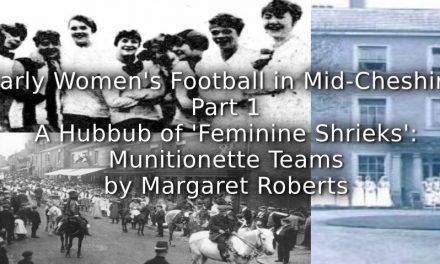As the profile of women’s football increases more of its participants are becoming household names. Some of today’s stars, such as Sue Smith, Alex Scott and Karen Carney have become personalities beyond football, making an almost seamless transition between the pitch and the media gallery. Suzanne Grant Winters during her playing career won a full set of domestic trophies in Scotland and England with Glasgow City and Arsenal as well being capped for Scotland, is now a regular contributor on Sky Sports News. Observers may think that this is a recent phenomenon but there is a notable example of women players becoming media sensations from the early 1890s. I am grateful for the contribution of John and Rosalind Russell and William Webber who supplied much of the information and photographs contained in this article.
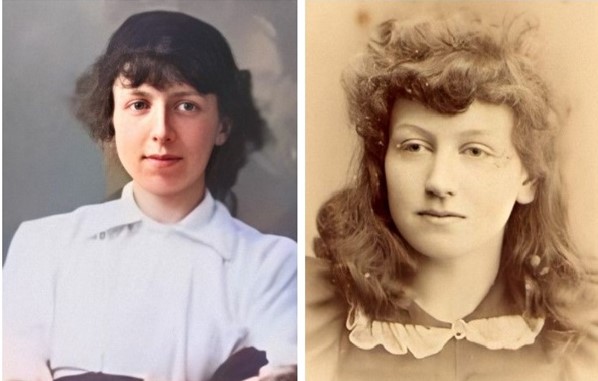
Helen (right) and Florence Matthew footballers and also co-authors of the ‘Lothian Lasses’ column which appeared in the Lancashire and Liverpool newspapers between 1891 and 1894
Images courtesy of John Russell.
During the autumn of 1891 the editor of the sports paper The Football and Cricket Field received an article on the match between the Canadian/US touring side and Everton League at Anfield, signed the ‘Lothian Lasses’.1The ‘Lasses’ were sisters Helen and Florence Matthew the daughters of ship’s captain William Matthew from Littleham in Devon. Helen later claimed to have come from Montrose, but her birth records show that she was born in London in 1871.2Her father William however did hail from the town, and it is likely that Helen spent at least some time in Montrose. The Matthew family moved from Littleham in 1880 settling at Carisbrooke Road in Liverpool. In an 1896 press interview Helen Matthew indicated that she had been playing football for 12 years which puts her entry to the game at 1884 adding, ‘My sister was a really fine player, and we used to practise in the back garden at home long before making any appearance in public’.3 The first public appearances the sisters made were likely to have been made as part of the events organised by the Edinburgh born showman Alec Payne. The Era of February 1890 noted Payne’s forthcoming tour:
Mr Alec Payne, in addition to piloting a couple of parachute ladies this summer, will have a male and female football team to play in various characters. This is the outcome of the late theatrical football match in Liverpool, of which Mr Payne was captain.4
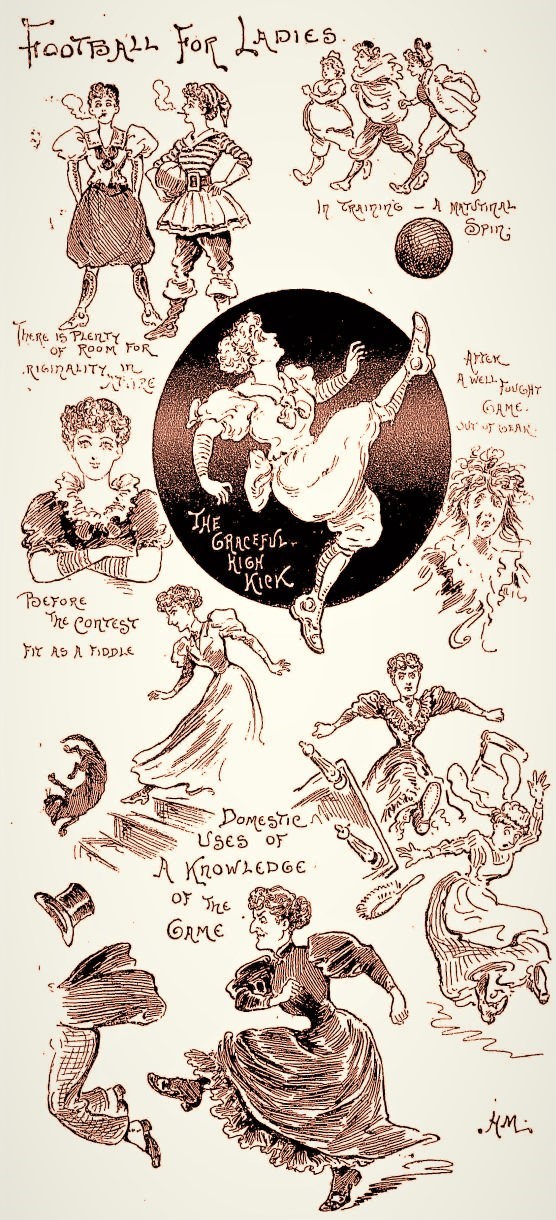
A panel featuring a selection of Helen Matthew’s sketches appeared in the comic paper Moonshine on April 6th, 1895. The top section records the sister’s early playing career while the lower section depicts the Matthew family, employing their football skills in the domestic setting
Image courtesy of John Russell.
Payne’s tour took in venues such as Pontypridd, Walsall and Wakefield. The Lady Footballers, however, went largely unmentioned with the bulk of the press attention centred on the Parachute Queen Cissie Kent. It was the arrival of the touring Canadian/US side at Anfield to play the Everton League that inspired the sisters to take to journalism. A few days later the Cricket & Football Field received an account of the match which it published under the heading ‘Our Lady Specialists at Anfield Road’ on 19th September 1891. A subsequent column published on 3rd October chronicled the opening of Woodcroft Park, home ground of the largely forgotten Liverpool Caledonia. The ‘Lasses’ noted the concerns of the visitors Everton at being ‘cut out’ by the new club and suggested that this fear was unfounded. This proved to be an astute observation as Liverpool Caledonian folded within two years of its inception.5
It seems that Florence produced the copy while Helen supplied artwork for the articles. Helen once wowed a correspondent of the Luton Times in 1895 with a quick-fire sketch of the Preston North End keeper James Trainer and there is also evidence that their mother Eliza contributed some sketches. Both Helen and Florence were fans of Preston North End, and their pen name ‘Lothian Lasses’ seems to be a reference to the Scottish influx into Preston North End which included such players as George Drummond, Nick Ross and his brother Jimmy. The ‘Lasses’ were fans of Nick Ross and continually informed their readers of their team loyalty. On one occasion they declared ‘N.E. are our one favourite team and can do no wrong except get beaten, when we long to visit them with a whip’.6 However even a draw such as 1-1 recorded against Everton on October 10th could be enough to confine the North End to the doghouse. The sister’s column came under the ‘Lothian Lasses’ heading for the first time on October 24th, 1891, when they visited Bolton’s ground, Pike Lane. And for the remainder of 1891 the ‘Lothian Lasses’ were featured in the Cricket and Football Field.
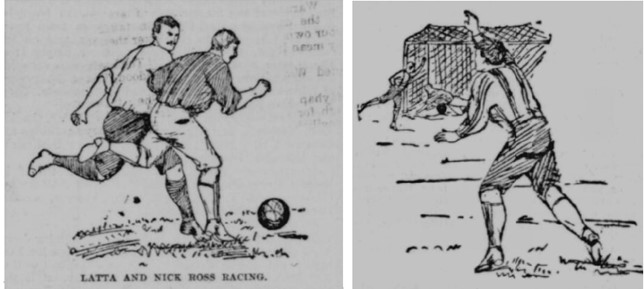
Illustrations by Helen Matthew of match incidents were a regular feature of the ‘Lothian Lasses’ column which appeared in the Cricket and Football Field, Liverpool Echo and Lancashire Evening Post between 1891 and 1894
Images BNA
By the early months of 1892, however, they had moved on to a new home the column appearing in the Liverpool Echo’s Saturday evening edition, its distinctive style soon making them local celebrities. The sisters were guests at the annual Boxing Day charity match between staff of the Express and Liverpool Echo. Before 5,000 spectators at Everton’s Goodison Park, Helen and Florence were introduced to Mayor, Robert Durning Holt, before taking up their duties as touchline officials.7Having young women in this role may have seemed novel but this system officiating matches had only been in use for one season. Previously two umpires nominated by each of the opposing clubs were the arbiters of a football match and the viewing public were still getting used to the new set up. From reports of the match the sisters seemed to perform well in what turned out to be a dour goalless draw. Soon after the charity match it was announced that the ‘Lothian Lasses’ column was moving once again, this time to the Lancashire Evening Post.
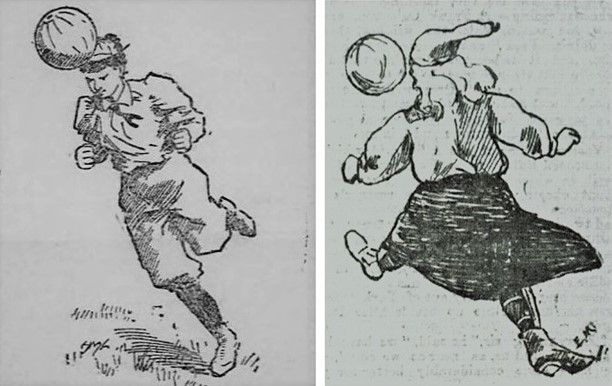
The image on the left is one of a series of illustrations of women footballers Helen Matthew drew for Evening News during November 1895 and initialled H.M.G, her alter ego Helen Matthews Graham
Right is a sketch of Helen in goal from April 1895.This sketch is initialled E.M and is likely to have been drawn by the sister’s mother, Eliza Matthew
Images courtesy of BNA.
Preston North End were one of the inaugural members of the football league winning the first two championships but were runners up for the 1891/92 season the first season the Lothian Lasses column. The 1892/93 season was little better and after a 2-1 loss at Deepdale to the eventual league winners Sunderland, Florence Matthew noted, ‘the curtain fell with Sunderland one goal ahead, and we didn’t know which we wished for most – coffins for ourselves, or that whip for North End’8. Preston had a mediocre start to the 1893/94 season exacerbated by Nick Ross having to leave the field against Bolton on November 4th, 1893. Suspected of suffering influenza – though more likely to have been tuberculosis – he recuperated at Southport. His attempts at making a return, however, floundered and he had to retire from a fixture against Darwin at Barley Bank on February 3rd, 1894.9Ross continued his recuperation during March and April in Madeira and the Canary Islands and he made the headlines when he saw a man struggling in the water from his hotel room on Grand Canary. Having rushed from his accommodation to enter the water he was able to bring the man to safety. It was later revealed that he was Richard Durning Holt, son of the former Liverpool Mayor, Robert Holt.10In the following months Nick Ross seemed to improve, and it was thought that he would return for the start of the new season. It therefore came as a great shock when Ross, at the age of 31, died on August 7th, 1894, at his home on Berry Street Preston. The Preston Herald of September 26th, 1894, noted that the ‘Lothian Lasses’ were organising a benefit for Ross’s widow and had approached Queens Park to provide the opposition for a League Select. The match played at South Shields on December 5th, 1894, however, was between Sunderland and the League Select and ended in 1-1 draw.11
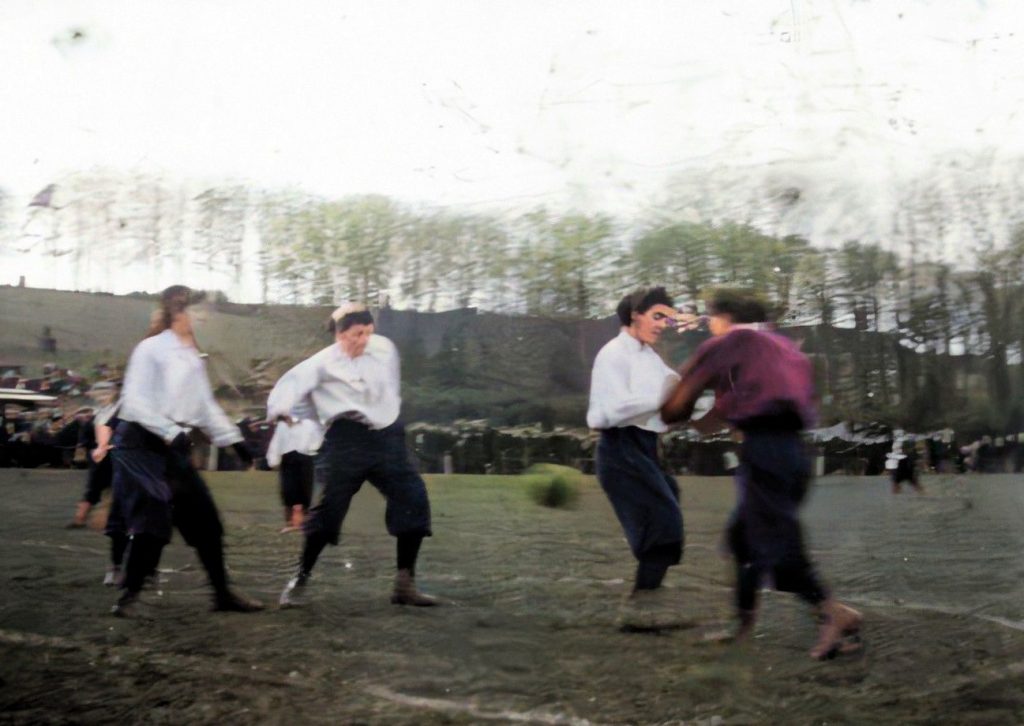
Helen Matthew (first on the left) in action during a match played at Loakes Park High Wycombe on November 11th, 1895
Helen appeared in goal under the name ‘Mrs Graham’
Image courtesy of Steve Peart.
Florence married Alexander William Thom Barkway, an Aberdeenshire man in the early months of 1894 and the ‘Lothian Lasses’ column had discontinued by the end of that year. In a later interview Helen noted: “my sister has lost a deal of interest in the game since her marriage”. Helen however was keen resume her football career and in the early months of 1895 made a spectacular return. In March 1895 she travelled to London to take part in the debut of the British Ladies Football Club. Appearing as ‘Mrs Helen Graham’ (Helen was still single) she told the press of her uncertainty about playing having received a foot injury in her pervious match. This seemed likely to have been in Birmingham for the short-lived Midland Ladies Football Club which was played at the Lower Aston Ground on March 4th, 1895.12 Helen needn’t have worried however as she shined not only the British Ladies debut but the club’s subsequent tour. Besides her football skills Helen also supplied artwork which was published by the Cardiff Evening News on November 2nd, 1895. Having been a local celebrity as one of the ‘Lothian Lasses’, Helen was propelled to national notoriety as one of the first stars of women’s football. As ‘Mrs Graham’, Helen led a second branch of the British Ladies Club with teams titled Mrs Graham’s XI and London & District. For the early months of 1896 Florence joined the club and for a match at Barley Bank in Darwin Mrs Graham’s XI changed its name to the ‘Lothian Lasses’.13 This was appropriate as Barley Bank was where Nick Ross made his last appearance as a player.
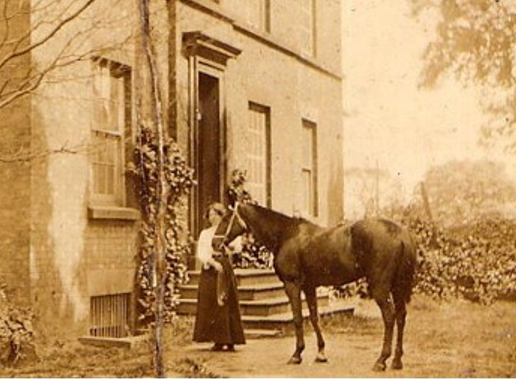
Helen Matthew pictured in 1908 with the racehorse ‘Blackbird’. During the 1900s she leased two horses ‘Captain’ and ‘Blackbird’ which she kept at the ‘The Hollies’ in Litherland
Image courtesy of John Russell.
Sporting all-rounder Frank Sugg refereed the teams at Rock Ferry with brother Walter Sugg acting as a linesman. Ahead of the match Helen acquired a set of new strips from Frank Sugg’s Liverpool sports store.14This would form the basis of a court case in 1900 in which the manager of Sugg’s store was charged with sending Helen a bogus county court order to receive payment for the shirts. At the trial Helen was named as ‘Helen Graham Matthews’ and this has formed the basis for a whole alternative history in which Helen organised the Lady Players of 1881 before becoming a suffragette.15However, investigations into name listed in trial coverage reveal it to be a fake. She often refereed to herself as Mrs Helen Graham and signed some of her artwork; H.M.G so it’s likely that the ‘Helen Graham Matthews’ listed in reports was an error by the court clerk. Helen left football after her branch of the British Ladies Club collapsed in July 1896 and spent the 1900s racing horses. Horse racing was a common target for the radical wing of the suffrage movement so it seems unlikely that Helen with her links to the racetrack would have been a suffragette, besides there is no evidence of the players being politically active. Helen continued to support football and remained affiliated to Preston North End. She followed their progress in the 1954 FA Cup, cheering them on in the final from a hospital bed in Newton Abbott. However, despite being ahead in the match Preston lost out in the end by 3-2 and it is rather unlikely that this aided her recovery.16
Article © of Stuart Gibbs
References/Notes
1 “Our Lady Specialists at Anfield”, Cricket and Football Field, 19 September 1891, 2
2 England & Wales, Civil Registration Birth Index, 1837 – 1915, Mile End, Old Town, (Reg; Jul, Aug, Sept 1871), digital image s.v. “Helen Jane Matthew”, Ancestry.com.
3 “The Lady Footballer”, South Wales Echo, 26 March 1895, 3
4 “Music Hall Gossip”, The Era, 22 February 1890, 17
5 “Our Lady Specialists at the Caledonia Opening”, Cricket and Football Field, 3 October 1891, 2
6 “Everton v Burnley by the Lothian Lasses”, Lancashire Evening Post, 27 December 1892, 4
7 “Echo v Express Charity Match”, Liverpool Daily Post, 27 December 1892, 6
8 “North End v Sunderland by the Lothian Lasses”, Lancashire Evening Post, 10 January 1893, 4
9 “North End v Darwin”, Preston Herald, 7 February 1894, 6
10 “Our “Clarion” Football Mixture”, The Clarion, 21 April 1894, 7
11 “Sunderland v Rest of League”, Newcastle Daily Chronicle, 6 December 1894, 7
12 “A Ladies Football Match at Aston”, Birmingham Daily Post, 5 March 1895, 7
13 “Sport and Play, Football”, Lancashire Evening Post, 22 January 1896, 4
14 “The ‘Original’ Lady Footballers”, Birkenhead News, 11 January 1896, 2
15 Helen Matthews Scottish Footballer and Suffragette, Peoplepill.com/people/helen matthews
16 Matthew, Helen. Helen Matthew to Elza Barkway, Newton Abbott Hospital, Devon, April 30, 1954.

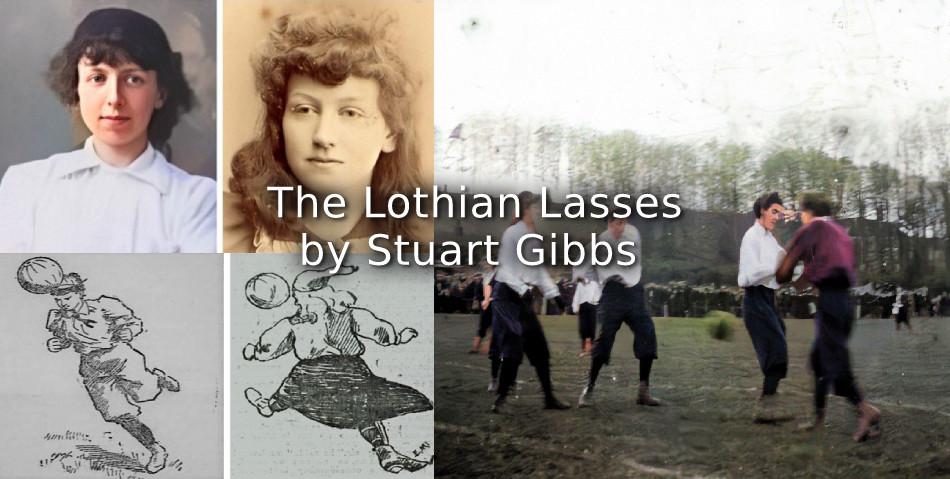
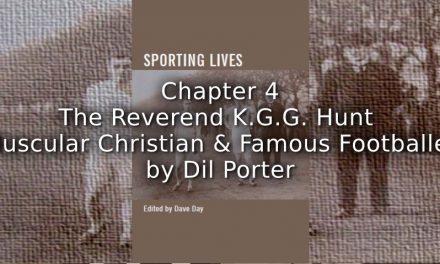
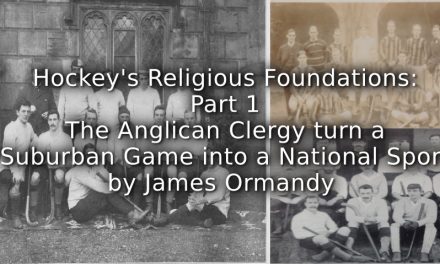
![Switching from Women’s Football to Cross-Country: <br>The History of Gruppo Sportivo Giovinezza [Milan, 1933-37]](https://www.playingpasts.co.uk/wp-content/uploads/2020/07/PP-banner-maker-440x264.jpg)
